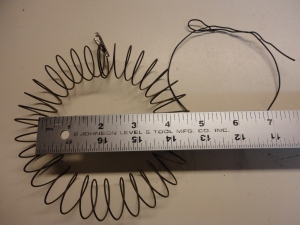Well, here I am, four days out from Christmas, and writing a blog on the easy Christmas sewing project I mentioned in my last post. Guess that pretty much tells you things didn’t go as quickly as I thought they would.
There’s been an old, soft, wool army blanket floating around here since forever. It’s actually two pieces of wool blankets sewn together. It’s been used under our tree many times and has been packed away with the Christmas stuff for the last 30+ years. One Christmas, when my kids were young, I said I was going to make a real tree skirt out of it someday, and it’s kind of been a running joke every year when we pull it out. Well, this is the year, I did it!
I love fabric and textures, but sewing has never really been my thing, I don’t know why. Not having a concrete plan for this project, I decided to approach it like I did most others, use what I have on hand, and visualize as I go.
I was able to fold and cut a 60” circle out of the darkest end of the blanket. There’s all kinds of easy instructions for folding fabric to cut large circles on the internet.
I traced the corner of a cup to cut a small hole in the center of the circle.


My first idea was to cut small holly pieces from the leftover end of the blanket and stitch them along the outer edge of the circle. But then, with such a big circle, I thought a larger pattern would look much better.
I drew a large holly leaf pattern about 20”L and 12”W, then cut eight holly pieces out of newspaper to arrange on the circle and give them a look. Sorry, the picture is a little fuzzy, but I liked the design.

Then, there was a hitch. I laid the holly pattern every which way and there was not enough leftover blanket to get the eight pieces out of. I could have made the pattern smaller, but I liked the big holly.
Just playing around, I cut the holly pattern in half lengthwise. Using two colors on the holly could add more interest. Half of the leaf could be cut from the leftover blanket, and something else could be used for the other half.
After two days of trying to find something to use, it finally dawned on me that I had the perfect thing all along, a faded pair of green army fatigues. As a saver of buttons, I always have a bag of old clothes waiting to have their buttons removed before they’re tossed, and that’s where I found them. The legs alone offered enough material and I could use the buttons too.

I didn’t have interfacing for the green cotton material. With plenty of the dark wool left, I cut eight pieces of that and adhered it to the back of the green cotton with a spray adhesive. I trimmed a few edges where they didn’t match neatly.


The design was laid out on the floor again and the pieces arranged where I wanted them. A slit opening was cut up through the center of one of the holly pieces. The pieces were adhered to the circle with spray adhesive. After the adhesive was dry, each piece of holly was surrounded with a six strand, dark brown blanket stitch. This step took me over a week to complete, there’s a lot of stitches. I’m sure my lack of experience in this area and only working evenings, slowed the process too.


More was needed, so I chose yo-yos. I cut eight 4” circles from the scrap green cotton material. After stitching them closed, they were painted with red fabric paint, giving them a deep rich red color. The buttons from the fatigues were sewn in the center of each yo-yo, then the yo-yos were sewn to the circle between the holly. I love the little yo-yos.

A zig-zag stitch was run around the outer edge of the skirt, and a strip of wool cut to fold over the raw edge of the small inner circle. My daughter, she’s a quilter, peeked in on me as I was pinning the wool strip into place, and offered me her binding clips to use. They’re the neatest little things. I stitched some knots to attach the strip, then ran a blanket stitch along the edge of it on both sides.

I found some tie strips in a craft drawer. I don’t know what they were off of, and they didn’t match, but that’s okay. They were stitched into place on the backside of the circle, along the edge of the slit opening.

And, finally, done. After all this time it feels pretty good to have this one particular project completed. I’m very happy with it.
I moved presents from under the tree to get a picture, then replaced them, covering my new creation. It’s a little wrinkly now, but it can make it’s grand debut Christmas morning after everyone has opened their gifts and Santa’s surprises.



Merry Christmas everyone, and many wishes for a bright, shiny New Year!


































































